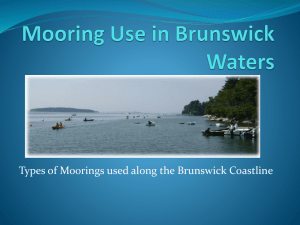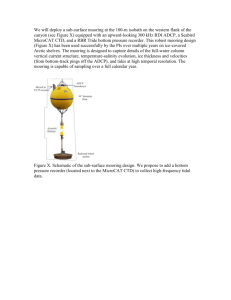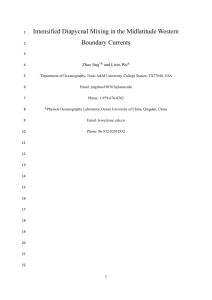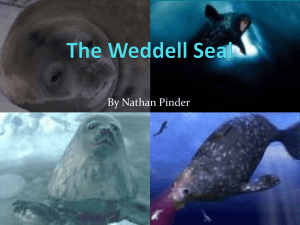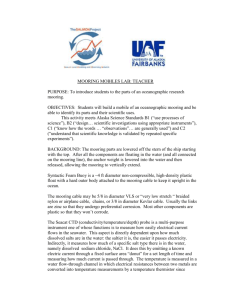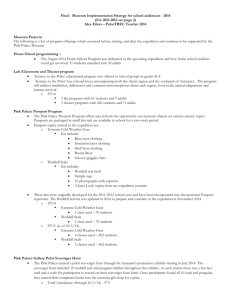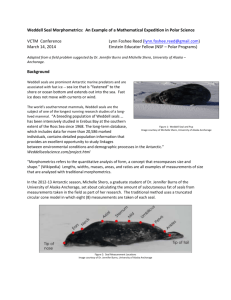ATLANTIC SITES – OceanSITES - Woods Hole Oceanographic
advertisement
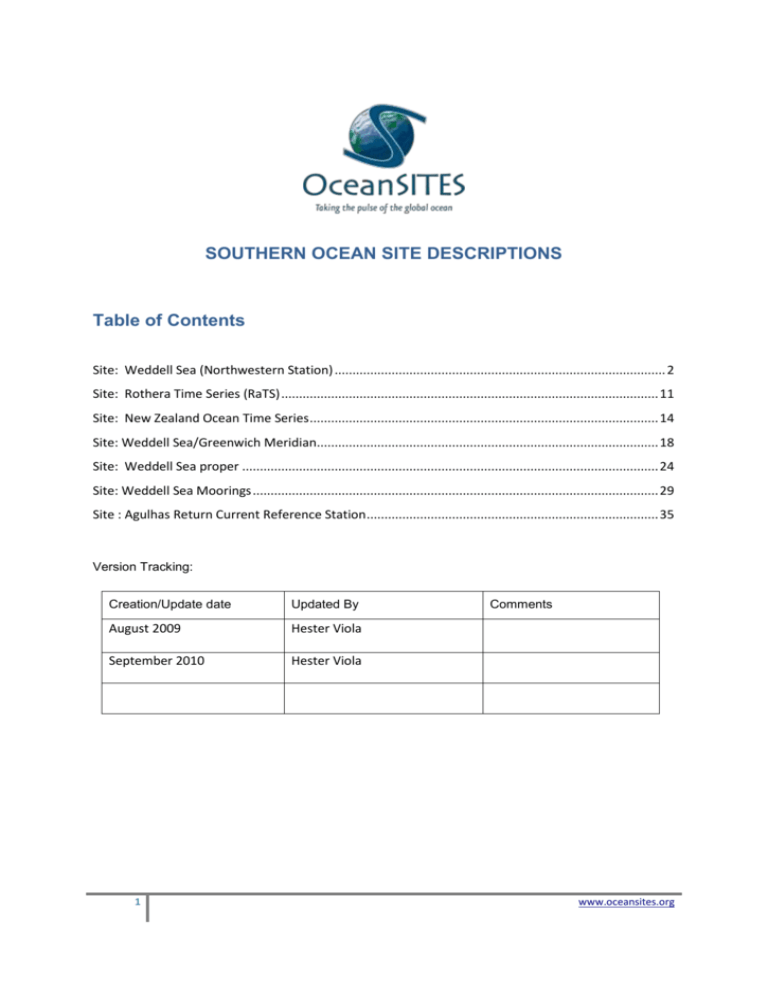
SOUTHERN OCEAN SITE DESCRIPTIONS Table of Contents Site: Weddell Sea (Northwestern Station) ............................................................................................. 2 Site: Rothera Time Series (RaTS) .......................................................................................................... 11 Site: New Zealand Ocean Time Series .................................................................................................. 14 Site: Weddell Sea/Greenwich Meridian................................................................................................ 18 Site: Weddell Sea proper ..................................................................................................................... 24 Site: Weddell Sea Moorings .................................................................................................................. 29 Site : Agulhas Return Current Reference Station .................................................................................. 35 Version Tracking: Creation/Update date Updated By August 2009 Hester Viola September 2010 Hester Viola 1 Comments www.oceansites.org Site: Weddell Sea (Northwestern Station) Position: ~62°S 44°W – 64°S 42°W Categories: operating; transport; physical, bottom water Safety distance for ship operations: 2 km Short description: 3 moorings maintained since 1999, with CTD/tracer stations occupied at and between the mooring sites when logistically feasible. Variables measured : Moorings: temperature, salinity, water velocities from the bottom to 500 m above bottom at approximately 100 m intervals. Sampling rates vary from 7.5 to 30 minutes. CTD/tracer: to within 10 m of the bottom at most stations. Water samples collected for analysis of CFC, transient tracers Start date of the timeseries, service interval: Moorings first deployed 1999; serviced at intervals dictated by available vessel time and local conditions [2000, 2001, 2005] Scientific rationale: The abyssal ocean is filled with cold, dense water that obtains it characteristics on the Antarctic continental shelf and by mixing while sinking along the slope. Recent estimates of water mass formation rates using CFC inventories suggest that a total of 8 Sv of Antarctic Bottom Water (AABW) are formed [Orsi et al. 1999]. The Weddell Sea Gyre transports about 5 Sv of Deep and Bottom water and thus contributes as much as 50% to the formation of AABW [e.g. Gordon et al. 2001, Fahrbach et al. 1994, 1995, Meredith et al. 2001]. Streams of relatively low salinity Weddell Sea Deep Water with temperature between 0° and -0.7°C are found along the outer rim of the Weddell Sea with varying degree of oxygen saturation (Figure 1) [Gordon et al. 2001]. Between 1989 and 1998 Fahrbach et al. [2001] deployed a current meter array east of Joinville Island which allowed for the first glimpse at interannual variability in temperature, thickness and transport of the WSBW formed in the Weddell gyre region. Starting in April 1999 LDEO/WHOI continued the time series at a down stream location south of the South Orkney Islands with a small mooring array (Figure 2) [Visbeck et al. 2001]. This location is easier to maintain since the sea ice covered season is shorter on average. Groups / P.I.s /labs /countries involved / responsible: The main effort is supported by LDEO (A. Gordon, W. Smethie, P. Schlosser). One mooring has been instrumented by WHOI (Toole). Some of the hydrographic work has been carried out in collaboration with a joint German/Brazilian program (Garcia, Hellmer). Funding has been received by NOAA, and the field work was made possible by arrangement with the NSF Office of Polar Programs. 2 www.oceansites.org Status: The world's deep oceans are filled with water masses formed at the continental margins of Antarctica. The Weddell Sea is a major source of these so-called Antarctic Deep and Bottom Waters. Relatively warm, saline Circumpolar Deep Water (CDW) enters the Weddell Gyre to the east of the Greenwich Meridian. As it traverses the gyre, it feeds bottom water-forming processes on the continental shelves, and interacts with floating ice shelves to produce a variety of Weddell Deep and Bottom water types. This project maintains three deep and bottom water focused moorings south of the South Orkney Islands in the Northwest Weddell Sea to provide a time series of the combined outflow (currents and temperature/salinity) of Antarctic Deep and Bottom Water drawn from various sites within the Weddell Sea. The moorings were initially installed and maintained as part of the NOAA-funded Consortium on Oceans Role in Climate: AbRupt climate CHangE Studies (CORC-ARCHES) Southern Ocean Modern Observations program. Figure 1. Location of the Weddell Sea moorings (red dots) and repeat CTD/Tracer line (dashed line). Shown schematically are the pathways of deep and bottom waters formed by interaction of WDW with continental and ice shelf waters. First installed in April 1999, the moorings have been serviced using ship time made available by other programs, primarily through the National Science Foundation Office of Polar Programs (OPP), and principal investigators funded by OPP who graciously allow our team to sail on their cruises. As time and resources allow during the mooring maintenance cruises, oceanographic stations to collect 3 www.oceansites.org profiles of conductivity, temperature and tracers (CTD/tracer) are occupied at the mooring sites and at stations distributed along a line between the mooring locations (Figure 1). The cost of ship time devoted to the mooring work and associated CTD/tracer stations, typically 3 to 5 days, has been supported by funding from OCO. More recently, ship time arrangements have been made with colleagues at the British Antarctic Survey (BAS), governed by an Agreement of Cooperation between LDEO and BAS. The agreement with BAS provides for sharing of equipment, personnel and data between LDEO and BAS to allow the mooring sites to be serviced at nominally two-year intervals, with BAS providing the ship time to do so. Our collaboration with BAS will continue, so this work is part of an international effort. The most recent rotation of the moorings was achieved from the BAS vessel RRS Ernest Shackleton in February-March 2007. The newest of the ARCHES moorings, M4, within the trough feeding Weddell water into the Scotia Sea is now part of an enhanced array of moorings in the trough, using LDEO and BAS equipment to better resolve this branch of bottom water spreading. We now have time series of currents, temperature and salinity of the outflow of dense water from the Weddell Sea spanning 8 years at M3 [Figure 2], which is positioned within the primary pathway of outflow of dense Weddell water, and 6 years at M2. The M2 gap of 2005 and 2006 was due to lack of ship time to re-deploy M2 after recovery in March 2005, but it has now been reinstalled in March 2007. The time series reveals significant seasonal and interannual variability in the outflow of dense Weddell Sea water. An annual pulse of the coldest bottom water at the mooring site is evident in the May-July time frame, which suggests [from the mean bottom speed] export of shelf water into the deep ocean at the upstream bottom water formation sites in the Dec-Feb period, i.e. austral summer [a rather unexpected discovery]. However, the exact timing of the outflow events and their temperature and salinity characteristics vary from year to year. The extended time series will contribute to an understanding the processes that control the transport and characteristics of the bottom waters that emanate from the Weddell Sea, as required to better assess the reaction of the Southern Ocean meridional overturning circulation and associated deep ocean ventilation to a warming climate. Research questions that could be pursued with the extended Weddell Sea time series include: are there any ‘environmental’ conditions, e.g. wind, sea ice, Larsen Ice shelf break-up, or climate oscillations such as the Antarctic Dipole, Southern Annular Mode, that can account for the seasonal and interannual fluctuations observed in the bottom flow passing the Weddell Mooring sites? How does the observed behavior of the Weddell MOC compare to model output? How might the Weddell Sea MOC change with climate warming? 4 www.oceansites.org Figure 2. M3 temperature and bottom speed time series. Accomplishments The performance period covered by this report is 1 July 2008 – 30 September 2008; no OCO funding was received in FY2007. To date, we have completed all preparations for a cruise on RRS Ernest Shackleton, to be carried out under a cooperative arrangement with colleagues at the British Antarctic Survey (BAS) to continue servicing the Weddell moorings, and to expand the array in conjunction with the BAS and other IPY programs in the region (Figure 3). The configuration of the joint LDEO-BAS array of moorings is shown in Figure 4. Data are archived and made available as they are recovered from the moorings at the project web site: http://www.ldeo.columbia.edu/res/div/ocp/projects/corc.shtml This web site will be upgraded during the next year. A preliminary analysis of the time-series data collected to date will be presented at the 2008 Fall The site has a nearly 8 year record [April 1999 to February 2007] of the currents and thermohaline stratification within the lower ~500 m of the water column at a mooring (M3) at 4565 m depth, south of the South Orkney Islands, positioned within the outflow of dense Weddell AABW. The time series reveals significant seasonal and interannual variability. A pulse of the coldest bottom water is evident in the May-July period, though the precise timing and duration varies with year. Intensification of the near bottom stratification is observed as the bottom water attains its coldest values. The coldest bottom events occurred in 1999 and 2002, while in 2000 it was absent. At bottom temperatures <0.8°C the salinity fluctuations produce a ‘fan-like’ appearance in T/S space suggesting a varied source of dense shelf water. The coldest bottom water <-1.0°C is relatively salty indicating a source in the southwest Weddell Sea, about 1300 km along isobaths to the mooring site. The typical bottom speed at M3 of 10-15 cm/sec implies a shelf water export time during the austral summer. A record at 5 www.oceansites.org a second mooring (M2) at 3059 m depth displays a much reduced annual cycle, but it too records a relatively warm period in 2000. Correlations of the M3 time series with NINO3.4 and SAM suggest that these indices lead M3 on the order of 14-20 months, implying a likely relationship between the water mass and surface forcing. Both M3 and M2 were reinstalled in March 2007. Figure 3. Planned mooring recovery/redeployment activities during RRS Ernest Shackleton cruise scheduled for Jan-Mar 2009. 6 www.oceansites.org Figure 4. Weddell mooring configurations and positions. RCM current meters will gradually be replaced with acoustic current meters. Additionally, new temperature and temperature/salinity recorders are purchased in off-field years and phased into the mooring array to allow for return and recalibration of older units. Technology: The ongoing program has two elements: A repeat hydrographic section across the northwestern Weddell gyre outflow including observations of trace elements (CFCs and Tritium/Helium) and an array of three moorings. Two of them are equipped with nominally two current meters, two TS recorder and several T recorders covering a 500m thick layer above the sea floor. The third mooring consists of a profiling CTD and current meter package which is capable of obtaining a 1000m long profile every other day. All moorings have internal recording only and it is not feasible to add 7 www.oceansites.org telemetry due to heavy sea ice. Data policy: delayed mode data: The mooring and CTD data are available to the public in delayed mode, to allow for preliminary processing of the data prior to public release. All available data can be accessed from the project web site. Data management: Under development. Societal value / Users / customers: The site is perfect to document changes in rates and types of bottom waters formed in the Weddell Sea. Even subtle changes in the climate system would be detectable and at some point can be compared with climate model solution. Note, however, that this is a region of the world where climate model simulations are quite inadequate. At this point assessments of the state of the global climate systems, such as the IPCC process are our customers. Role in the integrated global observing system: The global observing system is very thin in the Southern Hemisphere. Seasonal sea ice cover and its rather high latitude limit the amount of information that can be gained by space based measurements. Thus sites like this one contribute crucial and unique information that will be hard to get any other way. Contact Person: for enquiry about addition of instrumentation or sensors to the site or for possible ancillary measurements during cruises to the site: Prof Arnold Gordon (agordon@ldeo.columbia.edu) for information about the site or data : Bruce Huber (bhuber@ldeo.columbia.edu) Links / Web-sites: for Project information : for data access : http://www.ldeo.columbia.edu/res/div/ocp/projects/corc.shtml http://www.ldeo.columbia.edu/res/div/ocp/projects/corc.shtml compiled/ updated by: Bruce Huber (January 2009) 8 www.oceansites.org Figure 1: Potential temperature section south of the South Orkney Islands with the location of the mooring array superimposed. Inset: Bathymetric map of the Weddel Sea Gyre indicating the position of several streams of newly formed Weddell Sea Bottom Water [Gordon et al. 2001] and the CORC/ARCHES repeat section and mooring array [reproduced from Visbeck et al, 2001]. 9 www.oceansites.org Figure 2: Potential temperature time series as obtained from repeat hydrographic sections in the northwestern Weddell gyre. Diamonds denote the mean temperature between 2600 and 3200 m water depth near 62.5°S 43.5°W (near M2). Squares denote the mean temperature between 4000 and 4600 m water depth near 63.5°S 42.0°W (near M3). The bars covers the total range of observed temperatures. The thin gay lines represent the 40h low pass filtered temperatures averaged over all sensors at mooring M2 and M3 respectively. The stars are the plume mean temperatures from Fahrbach et al. (2001) at their upstream array location. The solid line connects the plume mean with the coldest temperature found during each survey [reproduced from Visbeck et al, 2001]. 10 www.oceansites.org Site: Rothera Time Series (RaTS) Position: Marguerite Bay (67S, 68W), on the western Antarctic Peninsula Categories: physical, biogeochemical, biological Safety distance for ship operations: There is often a mooring deployed at the RaTS site to augment the quasi-weekly CTD profiling and sampling. Vessels should thus avoid working around the RaTS site to a distance of at least 1nm, without having previously checked whether a mooring is in place. Short description: 1 repeat CTD station, plus associated sampling for biogeochemical/biological variables Variables measured : CTD (temperature, conductivity, depth) profiling to ~450m Photosynthetically-active radiation profiled to ~450m Fluorescence profiled to ~450m Oxygen Isotopes sampled at 15m Chlorophyll sampled at 15m Nutrients sampled at 15m Other biological parameters sampled at 15m Start date of the timeseries, service interval: Started late 1997; repeat measurements ~weekly, subject to ice. (Profiling through hole cut in ice in winter). Ancillary measurements. Through collaborations and soft funding, we periodically are able to deploy a mooring at the RaTS site to augment the quasi-weekly CTD profiling and sampling. This typically features sediment traps, upward-looking ADCP, moored CTDs, moored current meters, and temperature loggers. Scientific rationale: Antarctica as a whole is unusual in having a very deep continental shelf with relatively little freshwater or sediment input from rivers. It is, however, highly influenced by oceanographic processes associated with both surface ice and continental shelf ice. The Antarctic coastal marine system exhibits a marked seasonality, and also variability on a range of scales from interannual to Milankovitch. The RaTS site is towards the southern end of the Antarctic Peninsula, a region which has seen among the highest rates of regional climatic warming of the past 50 years. As the time series continues, we will be able to investigate the role of oceanographic variability on a range of timescales and its influence on the Antarctic marine ecosystem. We have already discerned the impact of ENSO variability on the physical ocean system, and are currently tracking its progression through the associated biogeochemical and ecological system. These ongoing measurements are needed to discern the evolution of the interdisciplinary marine environment in a region of rapid climate change. 11 www.oceansites.org Groups / P.I.s /labs /countries involved / responsible: Mike Meredith (BAS, UK) for physics Andrew Clarke (BAS, UK) for biogeochemistry and biology Status: Ongoing funding provided to the British Antarctic Survey by the UK Natural Environment Research Council as part of BAS's Long-Term Monitoring and Survey remit (LTMS) Technology: CTD and Niskin bottle sampling from small boat in Antarctic summer. When ice-covered, the sampling site is measured by cutting a hole through the ice, and conducting sledge-based profiling and sampling. A fixed mooring is periodically deployed at the RaTS site, through collaborations and soft funding bids. Data policy: delayed mode data: public (available on request) Data management: At present, profile data are relayed to UK by satellite (email). Some discrete samples analysed on base at Rothera Research Station; others returned to UK annually for laboratory analysis. Data are quality controlled at BAS, and lodged with the British Oceanographic Data Centre (BODC) for archiving and distribution - http://bodc-nerc.blogspot.com/2008/10/rothera-time-series-rats-data.html. Typically, data are available for up to 1 year behind present, since cal/val is applied annually to most measurements. Contact Person: Mike Meredith (physics, CTD, oxygen isotopes) Andrew Clarke (biology, biogeochemistry) Links / Web-sites: for Project information : some brief description on http://www.soc.soton.ac.uk/JRD/HYDRO/drake/rats.php A more up-to-date website is being developed. compiled / updated by: Mike Meredith (December 2004; revised December 2008). 12 www.oceansites.org Figure: Temporal progression of the upper-layer temperature at the RaTS site, for the period 19982006. Note, in particular, the very deep mixed layers in the austral winters of 1998 and 2003, caused by the ENSO events that were then decaying. Data coverage extends up to present date. 13 www.oceansites.org Site: New Zealand Ocean Time Series Position: 41.2 S 178.5 E and 46.6 S 178.5 E Categories: Observatory for physical, meteorological, biogeochemical measurements, CO2, particle flux, chlorophyll Safety distance for ship operations: 10 n miles Short description: 2 moorings: subtropical waters (STM) 41.2 S 178.5 E; subantarctic waters (SAM) 46.6 S 178.5 E Variables measured : 70 m depth (irradiance (10 minute mean), chlorophyll fluorescence (10 minute mean), temperature (hourly), salinity (hourly); temperature and salinity only at STM. 90 m depth CO2 (ten minute mean) at SAM only 100-150 m depth current speed and direction (10 minute mean), temperature (hourly), salinity (hourly); 1500 m depth downward particle flux (mass flux, POC, PIC, opal, PON) every 5-15 days, current speed and direction (10 minute mean), temperature (hourly). 3100 m depth current speed and direction (10 minute mean), temperature (hourly) at STM only Start date of the timeseries, service interval: The moorings have been deployed since October 2000. They were serviced every 4 months up until 2005 and have been turned around every 6-8 months since this time. During each servicing voyage, additional data are also collected (underway nutrients, deep CTD casts, plankton, ADCP, etc). Scientific rationale: The location of the Subtropical Front or Convergence, east of New Zealand, provides the opportunity to obtain detailed time-series data in each of two distinct waters masses - subtropical and subantarctic waters. In particular, these water masses exhibit different biological signals, with subtropical waters characterised by a classical spring and autumn phytoplankton bloom cycle, whereas subantarctic waters are perennially High Nitrate-Low Chlorophyll due to low dissolved iron concentrations. Our two identical moorings were designed to examine the degree of coupling between pelagic and deep water events in each of these water masses. We can assess if this coupling is stronger in the more productive subtropical waters relative to the subantarctic water mass. The latter, comprises a 10 degree N-S circumpolar ring and thus represents around 50% of the ice-free waters of the Southern Ocean. Thus, the data from the subantarctic water mooring will be of particular interest to the Southern Ocean biogeochemical community. Groups / P.I.s /labs /countries involved / responsible: The Ocean Ecosystems group at NIWA (NZ) runs the moorings with Craig Stewart, Steve Chiswell 14 www.oceansites.org and Phil Sutton responsible for the mooring design and physical instrumentation, Scott Nodder for the deepwater traps, Philip Boyd for the bio-optical instruments, and Kim Currie for the SAMI pCO2 sensor. We have close links with other NIWA groups working on Ocean Colour (Matt Pinkerton). We have links with other Southern Ocean mooring groups from Australia (Tom Trull, Bronte Tilbrook). Status: operating long-term plans funding status, source of funding: New Zealand Technology: deep-moored sensors data downloaded every 4 months up until 2005, now every 6-8 months SST measurements: Seabird MicroCATs on mooring Data policy: delayed mode data: not public at present – data dissemination via publications (Nodder et al. 2005) Data management: internal at present – to be discussed later in 2009 Societal value / Users / customers: Through assessment of the annual cycles of phytoplankton stocks and export of carbon to depth we are able to provide data to other New Zealand end-users on seasonal and interannual variability of these properties that will determine the carry capacity of local waters, and their ability to sequester carbon. We also have links with other groups with moorings in Southern Ocean waters (CSIRO) and can thus compare our findings at various sites in subantarctic waters. Role in the integrated global observing system: Contact Person: Scott Nodder/ Philip Boyd (s.nodder@niwa.co.nz, p.boyd@niwa.co.nz ) Links / Web-sites: http://www.agu.org/pubs/crossref/2005/2004JC002833.shtml - paper by Nodder et al., summarising the first year of the mooring deployments (2000-2001). Compiled / updated by: Scott Nodder (January 2009) 15 www.oceansites.org Figure 1: Spring bloom, October 2000 (ref: SeaWiFS, NASA, Orbimage with processing by NIWA). The waters east of New Zealand are a natural laboratory to study Subantarctic (SA), Subtropical (ST) and Subtropical Front/Convergence (STC) waters. The SA “ring” comprises 50% of the open Southern Ocean. Figure 2: Location of NZs two deep-ocean biophysical moorings: STM and SAM in subtropical (STW) and subantarctic (SAW) waters, respectively. The mean annual sea surface temperature field is superimposed in the background with the 500 m bathymetric contour also shown. STW, Subtropical Water; SAW, Subantarctic Water; STF, Subtropical Front; EAUC, East Auckland Current; ECC, East Cape Current; SC, Southland Current; WCC, Wairarapa Coastal Current; and WE, Wairarapa Eddy. [Copyright: American Geophysical Union, 2005; ref: S.D. Nodder, P.W. Boyd, S.M. Chiswell, M.H. Pinkerton, J.M. Bradford-Grieve, M.J.N. Greig (2005). Temporal coupling between surface and deep ocean biogeochemical processes in contrasting subtropical and subantarctic water masses, southwest Pacific Ocean, JOURNAL OF GEOPHYSICAL RESEARCH, VOL. 110, C12017, doi:10.1029/2004JC002833, 2005]. 16 www.oceansites.org 17 www.oceansites.org Site: Weddell Sea/Greenwich Meridian Position: 59°S 0° to 69°S 0° Categories: operating; Observatory, Transport; physical, sea ice Safety distance for ship operations: subsurface moorings 2 nm from each mooring Short description: 5 moorings (positions see table 1) Variables measured: currents, T, S, p, sea ice (for details see table 1) Start date of the time series, service interval: First deployment 1996. Last redeployment in 2008. The available mooring technology allows three year mooring periods. The required ship time is provided by AWI with the icebreaking research vessel “Polarstern.” Scientific rationale: On the Greenwich Meridian water masses enter the formation areas of bottom water from the east, newly formed bottom water fills the basin from the west and Maud Rise represents a topographic feature which has the potential to induce the formation of a large polynya with consequent deep water formation in the open ocean. Therefore the Greenwich Meridian is a key area where the status of the Weddell Sea as a water mass formation area can be monitored The measurements consist of large scale hydrographic sections with a repeat cycle between 2 and 4 years and moored instruments to avoid effects of alising. The observed parameters are used to estimate water mass properties and transports are temperature, salinity, CO 2, CFCs, currents and ice thickness. The moored observing system is maintained in the Weddell Sea Convection Control (WECCON) project since 1996 with minor modifications. Current meter moorings were exchanged in 1998, 1999, 2001, 2003, 2005 and 2008. A redeployment is planned for the austral summer 2010/2011. The moorings are mainly equipped with current meters, temperature and conductivity sensors (Tab.1). The mooring work occurs in cooperation with the University Bergen, Norway. Additional to the moorings, vertically profiling floats are deployed in the context of the Argo programme. The moorings carry sound sources for RAFOS location of the floats. Upward looking sonars in 150 m depth are installed on 4 moorings in the framework of WCRP’s Antarctic Sea-Ice Thickness Project (AnSITP) to determine the sea ice transports (http://www.awi-bremerhaven.de/Research/IntCoop/Oce /ansitp/index.html). In 1996, 1998, 1999, 2001, 2003, 2005, 2008 hydrographic surveys were carried out along the Greenwich Meridian with a CTD-probe (Conductivity/Temperature/Depth) combined with a rosette water sampler). A repeat of this transect is planned for 2010/2010. The continuation is envisaged. To monitor the ACC transports a series of PIES is deployed In a final state 8 PIES will be located along a Jason track from the northern end of the mooring line toward South Africa. Groups / P.I.s /labs /countries involved / responsible: Eberhard Fahrbach and Olaf Boebel (Alfred-Wegener-Institut für Polar- und Meeresforschung) Status: operating time horizon / long-term plans: funding assured until 2010/2011 funding status, source of funding: The project is part of the Southern Ocean research project of the Alfred-Wegener-Institut für Polar- und Meeresforschung within the framework of the PACES 18 www.oceansites.org Programme of the Helmholtz-Gemeinschaft Deutscher Forschungszentren. Technology: moored sensors see Tab. 1 SST measurements: only during CTD transects. Profile measurements: In the moorings only point measurements in different levels see Tab. 1. Data policy: delayed mode data: available after recovery, processing and evaluation Data management: Metadata scheme : See AWI data bank and CLIVAR data system Possibilities of evolution to comply with a more general JCOMM GTS scheme: Installation of profilers to allow quasi real time data transfer according technical feasibility and funding. Societal value / Users / customers: Science Role in the integrated global observing system: The moorings provide data to monitor the status of a significant water mass formation area. However, they are very much influenced be the local conditions. Therefore, repeat hydrography has to cover a larger area to extend the observations over different water mass regimes. The repeat sequence of 2 to 4 years includes a large risk by aliasing and can not replace the moored instruments. We expect that the moorings will be part of the Southern Ocean Observing System (SOOS). The focus and related to that the location might shift towards the acoustic float tracking for which the location of the sound sources might need to be adapted. Contact Person: Gerd Rohardt: Gerd.Rohardt@awi.de Links / Web-sites: for Project information: Eberhard Fahrbach (Eberhard.Fahrbach@awi.de) for data access : Gerd.Rohardt@awi.de Compiled / updated by : Eberhard Fahrbach (March 2009) 19 www.oceansites.org 227 0 229 230 231 232 1000 Depth (m) 2000 3000 4000 Aanderaa Current Meter SBE CT or CTD LongRanger ADCP CMR Upward Looking Sonar String of SBE CT-Sensors 5000 Sound Source 52 54 56 58 60 62 64 66 68 S 70 Latitude Figure Moorings deployed in February 2008 along the Greenwich Meridian. Table 1 Moorings deployed on the Greenwich meridian Mooring Latitude Water Depth Longitude Date Instrument Serial Instrument Time Type Number Depth (m) 1. Record AWI232-9 20 68° 59.74’ S 3419 11.03.2008 (m) ULS 57 150 www.oceansites.org 00° 00.17’ E AWI231-8 66° 30.68’ S 14:00 4546 00° 01.81’ W AWI230-6 66° 01.13’ S 00° 04.77’ E 21 3577 AURAL 085 366 ADCP 6240 450 AVT 9782 750 RCM 11 144 1800 SBE37 2086 3300 RCM 11 486 3300 07.03.2008 ULS 56 150 22:00 SBE37 1236 200 SBE37 449 300 SBE37 2088 400 ADCP 825 450 SBE37 2089 500 SBE37 2090 600 SBE37Pu 1237 700 AVTP 10928 700 SQ 30 850 AVT 9180 1800 SBE37 237 4500 AVT 9186 4500 08.03.2008 AVTP 3517 200 14:00 SBE37Pu 1229 200 SBE37 2091 300 SBE37 2092 400 SBE37 2093 500 SBE37 2094 600 SBE37Pu 2237 700 RCM 11 295 700 AVTP 9188 1600 SBE37 2099 3400 www.oceansites.org AWI229-8 63° 58.03’ S 5195 00° 003.10’ W AWI227-10 59° 04.10’S 00° 04.88’ W 4630 RCM 11 504 3400 28.02.2008 ULS 64 150 18:00 SBE 37 2098 200 SBE37 2096 300 ADCP 5373 350 SBE16 2416 400 SBE37 2099 500 SBE37 2100 600 SBE37Pu 2396 700 AVTP 10925 704 SQ 29 850 AVT 9390 2000 SBE37 2101 5150 AVT 10499 5150 SBE37P10 1565 4580 25.02.2008 14:00 Abbreviations: ADCP RD-Instruments, Self Contained Acoustic Doppler Current Profiler AVTCP Aanderaa Current Meter with Temperature-, Conductivity-, and Pressure Sensor AVTP Aanderaa Current Meter with Temperature- and Pressure Sensor AVT Aanderaa Current Meter with Temperature Sensor RCM 11 Aanderaa Doppler Current Meter SBE16P# SeaBird Electronics intern recording CTD measuresTemperature, Conductivity, and Pressure, Type: Seacat; P# indicates the Depth Rating, e.g. P1 up to 1000psi or P3 up to 3000psi ULS Upward Looking Sonar; Christian Michelsen Research Inc. SBE26 SeaBird Electronics to measure the Bottom Pressure SBE37 SeaBird Electronics, Type: MicroCat, to measure Temperature and Conductivity SBE37Pu SeaBird Electronics, Type: MicroCat, to measure Temperature and Conductivity including external Pump SBE37PuP# SeaBird Electronics, Type: MicroCat, to measure Temperature and Conductivity 22 www.oceansites.org including external Pump and Pressure Sensor; P# indicates the Depth Rating, e.g. P3 up to 3000psi or P7 up to 7000psi and P35 for 3500 dbar SQ Sound Source for SOFAR-Floats SR Sound Recorder 23 www.oceansites.org Site: Weddell Sea proper Position: 63° 28.77’ S 52° 05.77’ W to 68° 59.70’ S 06° 56.70’ W Categories: operating; Observatory; physical, sea ice Safety distance for ship operations: subsurface moorings 2 nm from each mooring Short description: 8 moorings Variables measured: currents, T, S, p, sea ice (for details see table 1) Start date of the timeseries, service interval: First deployment 1989. Interruption 1996 until 2005. Last redeployment in 2008. The available mooring technology allows two year mooring periods. The required ship time is provided by AWI with the icebreaking research vessel “Polarstern.” Scientific rationale: In the Weddell Sea proper newly formed bottom and deep water is accumulated and provides a naturally low passed record of the time history of bottom and deep water formation. Additionally the Weddell Sea proper represents particular ice conditions which are supposed to be representative for the Atlantic sector of the Antarctic Ocean. The measurements consist of large scale hydrographic sections with a repeat cycle between 2 and 4 years and moored instruments to avoid effects of alising. The observed parameters are used to estimate water mass properties and transports are temperature, salinity, CO 2, CFCs, currents and ice thickness. The moored observing system is maintained in the Weddell Sea Convection Control (WECCON) project since 1996 with various modifications. Current meter moorings were redeployed in 2005 after a break in 1996 and redeployed in larger number in 2008. A redeployment is planned for the austral summer 2010/2011. The moorings are equipped with current meters, temperature and conductivity sensors and some with bottom pressure recorders (Tab.1). Additional to the moorings, vertically profiling floats are deployed in the context of the ARGO programme. The moorings carry sound sources for RAFOS location of the floats. Upward looking sonars in 150 m depth are installed in the framework of WCRP’s Antarctic Sea-Ice Thickness Project (AnSITP) to determine the sea ice transports. In 1989, 1990, 1993, 1996, 1998, 2005, 2008 hydrographic surveys were carried out in the Weddell Sea with a CTD-probe (Conductivity/Temperature/Depth) combined with a rosette water sampler). A repeat of this transect is planned for 2010/2011. The continuation is envisaged. Groups / P.I.s /labs /countries involved / responsible: Eberhard Fahrbach (Alfred-Wegener-Institut für Polar- und Meeresforschung) Status: operating time horizon / long-term plans: Funding assured until 2010/2011. It is planned to maintain the measurements to quantify decal variability. funding status, source of funding: 24 www.oceansites.org The project is part of the Southern Ocean research project of the Alfred-Wegener-Institut für Polarund Meeresforschung within the framework of the PACES Programme of the HelmholtzGemeinschaft Deutscher Forschungszentren. Technology: moored sensors see Tab. 1 SST measurements: only during CTD transects. Profile measurements: In the moorings only point measurements in different levels see Tab. 1. Data policy: delayed mode data: data available after recovery, processing and evaluation. Data management: Metadata scheme: See Pangaea WDC-D and CLIVAR data system Possibilities of evolution to comply with a more general JCOMM GTS scheme : Installation of profilers to allow quasi real time data transfer according technical feasibility and funding. Societal value / Users / customers: Science Role in the integrated global observing system: The moorings provide data to monitor the status of a significant water mass formation area. However, they are very much influenced be the local conditions. Therefore, repeat hydrography has to cover a larger area to extend the observations over different water mass regimes. The repeat sequence of 2 to 4 years includes a large risk by aliasing and can not replace the moored instruments. We expect that the moorings will be part of the Southern Ocean Observing System (SOOS). The focus and related to that the location might shift towards the acoustic float tracking for which the location of the sound sources might need to be adapted. Contact Person: Gerd Rohardt: Gerd.Rohardt@awi.de Links / Web-sites: for Project information: Eberhard Fahrbach (Eberhard.Fahrbach@awi.de) for data access : Gerd.Rohardt@awi.de Compiled / updated by : Eberhard Fahrbach (March 2009) 25 www.oceansites.org 206 207 216 0 217 208 209 500 1000 Depth (m) 1500 2000 2500 3000 3500 Aanderaa Current Meter SBE CT or CTD LongRanger ADCP CMR Upward Looking Sonar Joinville I. 4000 4500 Sound Source to Kapp Norvegia 5000 0 200 400 600 800 Distance (nm) Figure 1 Moorings deployed in March 2008 in the Weddell Sea. Table 1 Moorings deployed along transect from Kapp Norvegia towards Joinville Island Mooring Latitude Water Depth Longitude Date Instrument Serial Instrument Time Type Number Depth (m) 1. Record AWI244-1 68° 59.70’ S 2927 06° 56.70’ W AWI245-1 69° 03.68’ S 26 66° 36.89’ S SQ 23 850 SQ 24 850 SBE 16 2415 300 16:00 4466 17° 25.89’ W AWI209-5 13.03.2008 (m) 15.03.2008 16:00 4864 18.03.2008 www.oceansites.org 27° 07.08’ W AWI208-5 6° 36.85’ S 20:00 4770 36° 24.43’ W AWI217-3 64° 23.63’ S 4456 45° 52.38’ W AWI216-3 63° 54.03’ S 3516 49° 04.68’ W AWI207-7 63° 42.74’ S 2500 50° 50.55’ W AWI206-6 63° 28.77’ S 52° 05.77’ W 27 950 SQ 34 800 SBE37P 220 4800 SBE37 230 4850 21.03.2008 ULS 62 150 16:00 ADCP 3813 300 SBE16 1979 300 SBE37 435 4680 SBE37 2234 4730 24.03.2008 SQ 32 850 14:00 SBE37 250 4150 SBE37 240 4350 RCM 11 296 4351 26.03.2008 SBE37 2392 3350 16:00 SBE37 2393 3400 SBE37 439 3450 RCM 11 298 3451 27.03.2008 ULS 60 150 20:00 AVTP 10872 250 SBE 16 2414 251 AVT 10503 750 SQ 36 850 SBE37 2610 2100 SBE37 2297 2200 AVT 10530 2300 SBE37 436 2490 RCM 11 619 2490 ULS 61 150 AVTP 9206 250 SBE37 1228 500 www.oceansites.org AVT 9201 501 SBE16 2422 700 SBE37 438 900 RCM 11 508 901 Abbreviations: AVTCP Aanderaa Current Meter with Temperature-, Conductivity-, and Pressure Sensor AVTP Aanderaa Current Meter with Temperature- and Pressure Sensor AVT Aanderaa Current Meter with Temperature Sensor RCM 11 Aanderaa Doppler Current Meter SBE16P# SeaBird Electronics intern recording CTD measuresTemperature, Conductivity, and Pressure, Type: Seacat; P# indicates the Depth Rating, e.g. P1 up to 1000psi or P3 up to 3000psi ULS Upward Looking Sonar; Christian Michelsen Research Inc. SBE26 SeaBird Electronics to measure the Bottom Pressure SBE37 SeaBird Electronics, Type: MicroCat, to measure Temperature and Conductivity SBE37Pu SeaBird Electronics, Type: MicroCat, to measure Temperature and Conductivity including external Pump SBE37PuP# SeaBird Electronics, Type: MicroCat, to measure Temperature and Conductivity including external Pump and Pressure Sensor; P# indicates the Depth Rating, e.g. P3 up to 3000psi or P7 up to 7000psi and P35 for 3500 dbar SQ Sound Source for SOFAR-Floats SR Sound Recorder 28 www.oceansites.org Site: Weddell Sea Moorings Description: The world's deep oceans are filled with water masses formed at the continental margins of Antarctica. The Weddell Sea is a major source of these so-called Antarctic Deep and Bottom Waters. Relatively warm, saline Circumpolar Deep Water (CDW) enters the Weddell Gyre to the east of the Greenwich Meridian. As it traverses the gyre, it feeds bottom water-forming processes on the continental shelves, and interacts with floating ice shelves to produce a variety of Weddell Deep and Bottom water types. This project maintains three deep and bottom water focused moorings south of the South Orkney Islands in the Northwest Weddell Sea to provide a time series of the combined outflow (currents and temperature/salinity) of Antarctic Deep and Bottom Water drawn from various sites within the Weddell Sea. The moorings were initially installed and maintained as part of the NOAA-funded Consortium on Oceans Role in Climate: AbRupt climate CHangE Studies (CORC-ARCHES) Southern Ocean Modern Observations program. Figure 1. Location of the Weddell Sea moorings (red dots) and repeat CTD/Tracer line (dashed line). Shown schematically are the pathways of deep and bottom waters formed by interaction of WDW with continental and ice shelf waters. First installed in April 1999, the moorings have been serviced using ship time made available by other programs, primarily through the National Science Foundation Office of Polar Programs (OPP), and principal investigators funded by OPP who graciously allow our team to sail on their cruises. As time and resources allow during the mooring maintenance cruises, oceanographic stations to collect profiles of conductivity, temperature and tracers (CTD/tracer) are occupied at the mooring sites and at 29 www.oceansites.org stations distributed along a line between the mooring locations (Figure 1). The cost of ship time devoted to the mooring work and associated CTD/tracer stations, typically 3 to 5 days, has been supported by funding from OCO. More recently, ship time arrangements have been made with colleagues at the British Antarctic Survey (BAS), governed by an Agreement of Cooperation between LDEO and BAS. The agreement with BAS provides for sharing of equipment, personnel and data between LDEO and BAS to allow the mooring sites to be serviced at nominally two-year intervals, with BAS providing the ship time to do so. Our collaboration with BAS will continue, so this work is part of an international effort. The most recent rotation of the moorings was achieved from the BAS vessel RRS Ernest Shackleton in February-March 2007. The newest of the ARCHES moorings, M4, within the trough feeding Weddell water into the Scotia Sea is now part of an enhanced array of moorings in the trough, using LDEO and BAS equipment to better resolve this branch of bottom water spreading. We now have time series of currents, temperature and salinity of the outflow of dense water from the Weddell Sea spanning 8 years at M3 [Figure 2], which is positioned within the primary pathway of outflow of dense Weddell water, and 6 years at M2. The M2 gap of 2005 and 2006 was due to lack of ship time to re-deploy M2 after recovery in March 2005, but it has now been reinstalled in March 2007. The time series reveals significant seasonal and interannual variability in the outflow of dense Weddell Sea water. An annual pulse of the coldest bottom water at the mooring site is evident in the May-July time frame, which suggests [from the mean bottom speed] export of shelf water into the deep ocean at the upstream bottom water formation sites in the Dec-Feb period, i.e. austral summer [a rather unexpected discovery]. However, the exact timing of the outflow events and their temperature and salinity characteristics vary from year to year. The extended time series will contribute to an understanding the processes that control the transport and characteristics of the bottom waters that emanate from the Weddell Sea, as required to better assess the reaction of the Southern Ocean meridional overturning circulation and associated deep ocean ventilation to a warming climate. Research questions that could be pursued with the extended Weddell Sea time series include: are there any ‘environmental’ conditions, e.g. wind, sea ice, Larsen Ice shelf break-up, or climate oscillations such as the Antarctic Dipole, Southern Annular Mode, that can account for the seasonal and interannual fluctuations observed in the bottom flow passing the Weddell Mooring sites? How does the observed behavior of the Weddell MOC compare to model output? How might the Weddell Sea MOC change with climate warming? 30 www.oceansites.org Figure 2. M3 temperature and bottom speed time series. Accomplishments The performance period covered by this report is 1 July 2008 – 30 September 2008; no OCO funding was received in FY2007. To date, we have completed all preparations for a cruise on RRS Ernest Shackleton, to be carried out under a cooperative arrangement with colleagues at the British Antarctic Survey (BAS) to continue servicing the Weddell moorings, and to expand the array in conjunction with the BAS and other IPY programs in the region (Figure 3). The configuration of the joint LDEO-BAS array of moorings is shown in Figure 4. Data are archived and made available as they are recovered from the moorings at the project web site: http://www.ldeo.columbia.edu/res/div/ocp/projects/corc.shtml This web site will be upgraded during the next year. A preliminary analysis of the time-series data collected to date will be presented at the 2008 Fall AGU meeting: Eight Year time series of the outflow of Weddell Sea Bottom water Arnold L. Gordon, Bruce A. Huber, Darren McKee, Xiaojun Yuan Lamont-Doherty Earth Observatory of Columbia University We present a nearly 8 year record [April 1999 to February 2007] of the currents and thermohaline stratification within the lower ~500 m of the water column at a mooring (M3) at 4565 m depth, south of the South Orkney Islands, positioned within the outflow of dense Weddell AABW. The time series reveals significant seasonal and interannual variability. A pulse of the coldest bottom water is evident in the May-July period, though the precise timing and duration varies with year. Intensification of the near bottom stratification is observed as the bottom water attains its coldest values. The coldest bottom events occurred in 1999 and 2002, while in 2000 it was absent. At bottom temperatures <0.8°C the salinity fluctuations produce a ‘fan-like’ appearance in T/S space suggesting a varied 31 www.oceansites.org source of dense shelf water. The coldest bottom water <-1.0°C is relatively salty indicating a source in the southwest Weddell Sea, about 1300 km along isobaths to the mooring site. The typical bottom speed at M3 of 10-15 cm/sec implies a shelf water export time during the austral summer. A record at a second mooring (M2) at 3059 m depth displays a much reduced annual cycle, but it too records a relatively warm period in 2000. Correlations of the M3 time series with NINO3.4 and SAM suggest that these indices lead M3 on the order of 14-20 months, implying a likely relationship between the water mass and surface forcing. Both M3 and M2 were reinstalled in March 2007. Figure 3. Planned mooring recovery/redeployment activities during RRS Ernest Shackleton cruise scheduled for Jan-Mar 2009. 32 www.oceansites.org Figure 4. Weddell mooring configurations and positions. RCM current meters will gradually be replaced with acoustic current meters. Additionally, new temperature and temperature/salinity recorders are purchased in off-field years and phased into the mooring array to allow for return and recalibration of older units. Contact person: Project Manager: Bruce A. Huber Senior Staff Associate Lamont-Doherty Earth Observatory of Columbia University; 61 Route 9W Palisades, NY 10964-8000 tele: 845 365-8329 fax: 845 365-8157 bhuber@ldeo.columbia.edu 33 www.oceansites.org Co-Investigator: Arnold L. Gordon Professor of Oceanography Lamont-Doherty Earth Observatory of Columbia University; 61 Route 9W Palisades, NY 10964-8000 tele: 845 365-8325 fax: 845 365-8157 agordon@ldeo.columbia.edu 34 www.oceansites.org Site : Agulhas Return Current Reference Station Project Name: NOAA PMEL Ocean Climate Stations (OCS) Position: Nominally 38.5S, 30E Equatorward of Agulhas Return Current Categories: Air-Sea Flux, Observatory; meteorological, physical, biogeochemical Safety distance for ship operations: 5 nm (9 km) Short description: 1 surface buoy with slackline (reverse catenary) mooring Variables measured: Surface: wind speed and direction (from a sonic anemometer), air temperature, relative humidity, rain, shortwave and longwave radiation, 1m sea surface temperature and salinity, barometric pressure; air and sea surface pCO2. Subsurface temperature at 25m. Subsurface sensors will increase after first year, pending funding. Ocean currents at 15 m All physical measurements are recorded at least every 10 minutes. Carbon measurements are every 3 hours. Start date of the time series: planned for Oct 2010-11-1 Service interval: once per year Scientific rationale: Similar to the Kuroshio Extension Observatory (KEO), the planned Agulhas Return Current (ARC) reference station will be located just equatorward of a western boundary current extension, where heat, carried poleward by the western boundary current is lost to the atmosphere. As such, both are in regions of intense air-sea interactions. The planned ARC station woold contribute to large collaborative process studies and have strong international partners. Funding is initially through NSF to expedited the deployment of ARC to coincide with the NSF-funded Agulhas Current Transport experiment, led by Dr. Beal (RSMAS). Longterm NOAA funding is pending. Shiptime for ARC is being provided through the Agulhas and Somali Current Large Marine Ecosystem (ASCLME) project. For phase 1, the ARC mooring would carry a reduced suite of sensors to monitor air-sea heat, moisture, momentum, and CO2 fluxes, surface temperature and salinity and near-surface 35 www.oceansites.org currents. In phase 2, additional subsurface sensors will be included. All surface and subsurface data are telemetered to shore in near-realtime and made available through the project website: http://www.pmel.noaa.gov/ocs/ in a variety of formats including the standard OceanSITES data format. Groups / P.I.s /labs /countries involved / responsible: Dr. Meghan Cronin NOAA / PMEL (ARC lead) Mr. Christian Meinig NOAA / PMEL (ARC Lead Engineer) Dr. Christopher Sabine NOAA / PMEL (ARC Lead Carbon Scientist) Status: planned time horizon / long-term plans: Long-term funding from NSF (for year 1) from NOAA-OCO (pending, continued) Technology: Moored / autonomous sensors real-time telemetry: Daily-averaged and spot meteorological, SST and SSS data transmitted via Service Argos. Hourly surface meteorological and subsurface physical data transmitted via Iridium. Carbon has daily transmissions of 3-hour measurements via Iridium. SST measurement: self-contained sensor attached to bridle at 1m below surface Profile measurements: Sensors will be included after 2010, pending funding. Sensors would be attached to slackline mooring (pressure sensors should be used to remap observations onto nominal depths). Data policy: real-time data: All data are public from primary telemetry system (Service Argos for meteorological, Iridium for subsurface and carbon). delayed mode data: High-resolution data will be made public within 6 months of recovery. Data management: Data Assembly Center (DAC): All data will be accessible through www.pmel.noaa.gov/ocs/data_del.html. Carbon data would be available from the Carbon Dioxide Information Analysis Center (CDIAC). Satellite data collection system: Likely Iridium for both physical and carbon data) Real-time data processing and distribution system: PMEL realtime processing, QA and web distribution. Metadata scheme: see website Possibilities of evolution to comply with a more general JCOMM GTS scheme: in compliance Societal value / Users / customers: 36 www.oceansites.org Agulhas Return Current Reference Station (ARC) users are anticipated to include the research community, weather and climate forecasting communities, and satellite and numerical weather prediction products assessments communities. Role in the integrated global observing system: The ARC mooring would serve as an air-sea flux reference site and as an observatory for the Agulhas Return region of the Southern Ocean. This is a data sparse area, and this mooring is expected to provide an invaluable source of data in a very difficult region to sample. Contact Person: for information about the site or data: Meghan Cronin (Meghan.F.Cronin@noaa.gov) for information about the carbon component: Chris Sabine (Chris.Sabine@noaa.gov) Links / Web-sites: for Project information: http://www.pmel.noaa.gov/ocs/arc.html for information on carbon system: http://www.pmel.noaa.gov/co2/moorings/ Compiled by: Meghan Cronin (June 2010) Figure 1. The ARC site (black square), shown in relation to the mean net surface heat flux Qnet into the ocean in units W/m 2, mean sea level (white contours), and the 3000 m isobath (black contours). Sea surface height contours can be interpreted as streamlines of the surface geostrophic flow. Qnet is from the OAFLUX product. 37 www.oceansites.org
